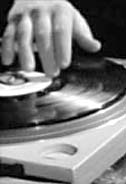
Movie Guru Rating:

Comment
on this review
| |

Groove is an exercise in techno self-congratulation
by Jesse Fox Mayshark
In San Francisco these days, there are people with full-time jobs who can't afford to pay rent. The service sector workforce, the people who clean the bathrooms and toast the multi-grain bagels for the dot-com dollar crowd, often have to commute 50 or 60 miles to do it. Mayor Willie Brown, always a man of the people, suggested last year that the city's just not a good place to be poor.
In Southern California, there's a small rural town that is paying residents $1,000 or more to move away, because the agriculture and industry that once supported the local economy have evaporated in a free trade haze.
Meanwhile, the NASDAQ shakeouts notwithstanding, the West Coast continues to sprout cell-phone addicted, mountain bike-riding, wired wannabe millionaires by the bushel.
None of which has anything to do with the movie Groove, at first glance. But it's worth keeping in mind. Because while it's ostensibly a profile of the Bay Area rave scene, the relatively charmless indie puff piece is really a celebration of a particular millennium mindset—the same one you see in all those Internet ads, where everyone is hipper, prettier, and richer than you, and damn proud of it.
First-time director Greg Harrison, who also wrote the script, was apparently trying to do for the late '90s what American Graffiti did for the early '60s and Dazed and Confused did for the mid-'70s. Groove starts out by introducing a diverse crew of characters and then follows their adventures through a single night of dancing, drugging, and self-discovering at an illegal warehouse party.
The difference is that unlike either of those predecessors, Groove doesn't give much sense that there's anything at stake here. True, the various characters have dilemmas and epiphanies as the night goes on—one young couple gets engaged, another celebrates an anniversary, an up-and-coming DJ gets to meet his idol—but it all seems so self-satisfied that it's hard to care. The writing is expository and lazy ("Hey, do you guys like jungle?" "Yeah, we love it!") and among the young cast members, only Mackenzie Firgens (as a girl who discovers her boyfriend maybe likes boys) and Lola Glaudini (as a New York transplant who's afraid she's raving her life away) make any dramatic impact.
The strangest thing about the film is that it was made at all, considering that raves as a cultural phenomenon stopped being new or interesting almost 10 years ago. Whatever genuine outlaw energy drove the first wave of parties in pastures and abandoned buildings and anywhere else someone could smuggle in a sound system has long since settled into bland ritual. Heck, Time and Newsweek got to the subculture before Groove did. Despite the mainstream media clucking about the occasional frat-boy overdose, it's clear the powers that be have let their dogs sniff around the rave scene and found it harmless. (Even the cops in the movie are indifferent to the ravers; they only bust them when they start to clog up the street outside.)
It's not hard to see why, at least on the evidence of Groove. The partiers in this film don't have anything on their minds but the party, the simple pursuit of sensory stimulation. Everything about the rave—the oh-so-late-'60s trippy light show, the relentless thump of the music, the abundant E and LSD, the kids themselves—is there just to be there. It's supposed to seem kind of Zen, I think, but it mostly seems vapid.
It's also hard to figure out who Groove is aimed at. The didactic explanations of everything rave-related (the neurological effects of MDMA, the mechanics of finding and occupying an empty warehouse, the word-of-mouth network that alerts partiers to upcoming events) seem like primers for novices, the kind of people who were shocked by the Newsweek articles. But why would they go to a movie about raves? Actual ravers, meanwhile, would probably find it hopelessly unhip.
Then, of course, there's the music. Harrison made a point of recruiting some of the West Coast's hottest DJs to contribute to the soundtrack and appear as themselves in the film. With their loopy nicknames (DJ Polywog, DJ Digweed) and cult followings, they're presented as the priests and priestesses of the makeshift temple, taking the dancers to ever-higher levels of energy, awareness and smiley-faced connectedness. The problem is, the experience doesn't translate very well to film. For all the pills and paper tabs consumed during the movie, it never really feels intoxicated. Compared to the hyperkinetic club scenes in Doug Liman's Go, for example, Groove seems flat. The music might sound cool if you were right in front of the speaker and on the right drugs. But if you're going to go to all that trouble, you'd be better off at an actual party than a cineplex.
The real point of Groove, and the only interesting thing about it, is scribbled in its margins. It's in the look-at-me techno-savvy of the rave organizers, the omnipresent Palm Pilots and digital pagers, the blithely name-branded athletic gear of the DJs and dancers, the flat stomachs and perfect pierced anatomy of the whole scene (which Harrison lingers over in solipsistic slo-mo). These kids are having a party not to escape the drudgery of their lives, to change the world, or even to show love for each other; they're having a party because they're young, they're pretty, and they're prosperous. It would be grumpy to begrudge them their fun. But Groove doesn't give much cause to join in it, either.

August 3, 2000 * Vol. 10, No. 31
© 2000 Metro Pulse
|